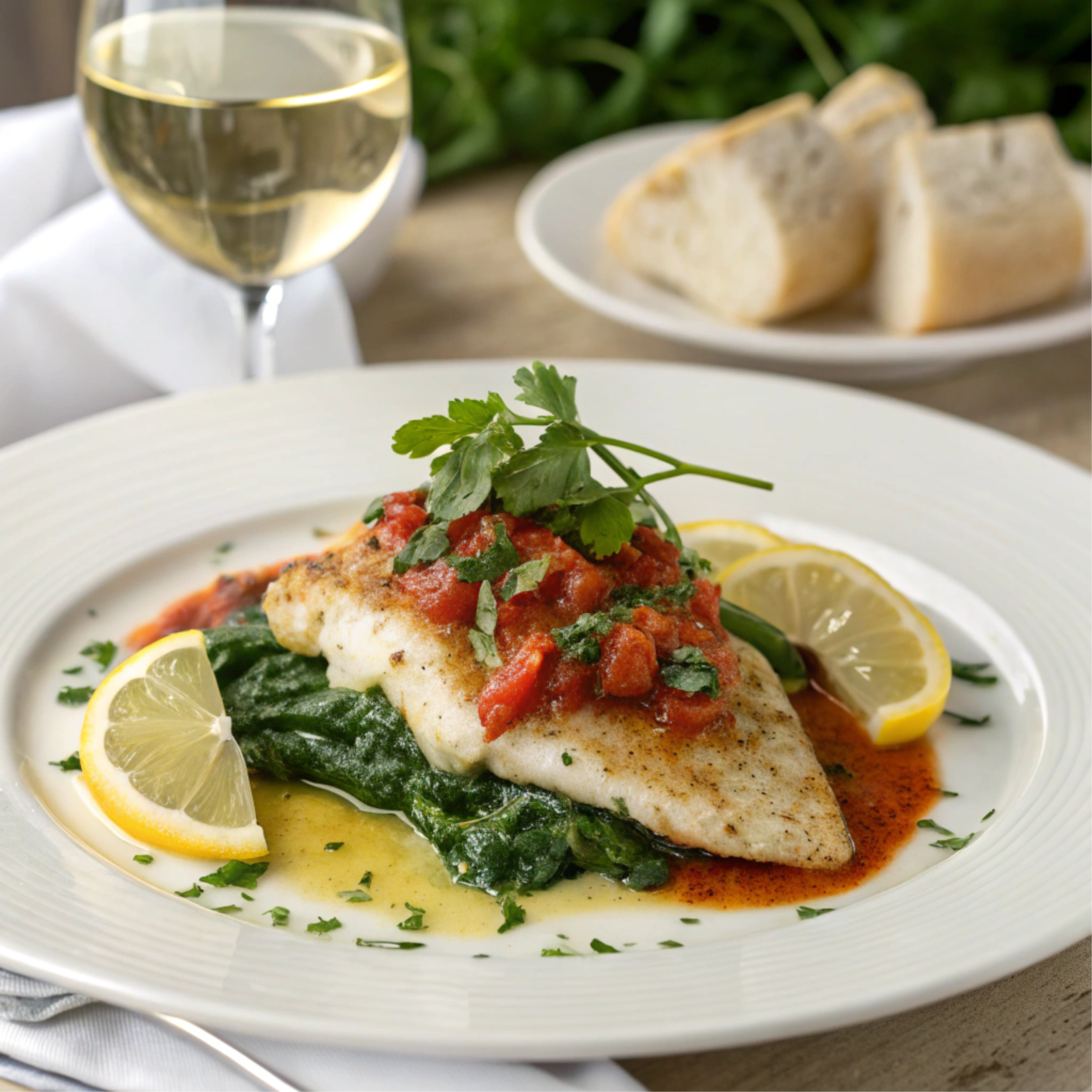Ingredients and Tools You’ll Need

Key Ingredients for Flounder Florentine
To make a mouthwatering flounder Florentine with spinach, you’ll need a few simple yet flavorful ingredients:
- Flounder fillets: Opt for fresh flounder if possible, but thawed frozen fillets work just fine. Make sure they’re boneless and skinless.
- Spinach: Both fresh and frozen spinach are great options. If using frozen, thaw and drain it thoroughly to avoid excess moisture.
- Cream sauce components: Butter, flour, milk, and a pinch of nutmeg form the base of the sauce. Nutmeg adds a warm, subtle flavor that pairs beautifully with spinach.
- Parmesan cheese: Grated Parmesan gives the dish a savory, cheesy finish. You can substitute it with cheddar or Gruyere for a twist.
- Seasonings: Salt, pepper, and a dash of paprika for color and smoky undertones.
Recommended Kitchen Tools
Having the right tools can make cooking flounder Florentine with spinach a breeze. Here’s what you’ll need:
- A 13×9-inch baking dish: For assembling and baking the dish.
- A saucepan: To prepare the cream sauce.
- Mixing tools: A whisk, spatula, and wooden spoon for blending ingredients smoothly.
- Cooking spray: To prevent sticking and ensure easy cleanup.
Gathering these ingredients and tools before you start cooking will save you time and ensure a seamless experience. With everything in place, you’re ready to move on to the fun part preparing and baking the dish!
Step-by-Step Guide to Cooking Flounder Florentine

Preparing the Spinach Base
Whether you’re using fresh or frozen spinach, preparation is key to achieving the perfect texture.
- Using frozen spinach: Thaw it completely, then place it in a clean kitchen towel. Squeeze out as much moisture as possible this prevents a watery dish.
- Using fresh spinach: Sauté a generous handful of spinach leaves in a skillet with a touch of olive oil or butter. Cook until wilted, then chop finely.
Spread the spinach evenly in the bottom of your greased baking dish.
Making the Cream Sauce
The cream sauce is what makes flounder Florentine with spinach so rich and satisfying. Follow these steps:
- Melt butter in a saucepan over medium heat, then sauté chopped onions until they’re soft and translucent.
- Stir in flour, whisking constantly to form a smooth roux. Cook for a minute to eliminate any raw flour taste.
- Gradually add milk, whisking as you pour to prevent lumps.
- Season with salt, pepper, and a pinch of nutmeg, then bring the sauce to a gentle boil. Cook for 2-3 minutes until thickened.
This creamy base will soak into the spinach and flounder, creating layers of flavor.
Assembling the Dish
Here’s where everything comes together:
- Lay the prepared flounder fillets over the spinach base in the baking dish.
- Pour the cream sauce evenly over the fish, ensuring it covers the entire surface.
- Sprinkle grated Parmesan cheese and a pinch of paprika on top for a golden, cheesy crust.
Baking to Perfection
Preheat your oven to 350°F (175°C). Place the baking dish on the middle rack and bake, uncovered, for 20-25 minutes. The fish is ready when it flakes easily with a fork.
Let the dish rest for a few minutes before serving. This allows the flavors to meld and makes it easier to plate.
Customizing Your Flounder Florentine
Adding More Vegetables
If you’re looking to pack even more nutrients into your flounder Florentine with spinach, consider adding extra vegetables. Not only do they add flavor and texture, but they also bring a splash of color to your dish.
- Broccoli florets: Steam lightly before mixing them with the spinach layer. The crispiness of broccoli contrasts beautifully with the creamy sauce.
- Green peas: Toss these sweet gems directly into the spinach for a pop of sweetness.
- Kale or Swiss chard: Sauté these hearty greens alongside spinach for a deeper, earthier flavor.
When adding extra veggies, ensure they are cooked or prepped beforehand to avoid excess water in the dish.
Using Different Cheeses
While Parmesan is a classic choice for flounder Florentine with spinach, experimenting with other cheeses can give the dish a new twist:
- Cheddar: Adds a sharp, tangy flavor that cuts through the creaminess.
- Gruyere: Melts beautifully and offers a nutty, savory touch.
- Boursin or herbed cream cheese: Infuses the dish with garlic and herb flavors.
Sprinkle your preferred cheese generously on top before baking to achieve a bubbly, golden crust.
Spice and Herb Enhancements
To boost flavor even further, try incorporating additional herbs and spices:
- Garlic: Mince fresh garlic into the cream sauce for an aromatic kick.
- Thyme or oregano: Sprinkle these herbs into the sauce for earthy, Mediterranean vibes.
- Saffron: A pinch of saffron threads in the cream sauce adds a subtle floral note and vibrant color.
Customizing flounder Florentine with spinach is all about balancing the flavors you love most. These simple adjustments ensure the dish feels fresh and unique every time you make it.
Serving Suggestions and Pairings
Perfect Side Dishes for Flounder Florentine
Pairing flounder Florentine with spinach with the right sides takes your meal to the next level. Here are a few ideas:
- Starches: Creamy risotto or buttery angel hair pasta work wonderfully to soak up the rich sauce. For something lighter, try roasted baby potatoes with a sprinkle of rosemary.
- Vegetables: Serve alongside garlicky sautéed spinach for a double dose of greens, or opt for roasted asparagus or green beans for a crunchy contrast.
- Crusty bread: A warm, crusty baguette or sourdough bread is perfect for mopping up every drop of that creamy sauce.
Best Wines to Pair with Flounder Florentine
Selecting the right wine enhances the flavors of the dish:
- Chardonnay: This full-bodied white wine complements the creamy sauce beautifully.
- Sauvignon Blanc: Its crisp, citrusy notes balance the richness of the dish.
- Non-alcoholic options: Sparkling water with a squeeze of lemon or lime keeps the meal fresh and light.
FAQs About Cooking Flounder Florentine
Can I Use a Different Fish in This Recipe?
Absolutely! While flounder is the traditional choice for flounder Florentine with spinach, you can easily substitute other mild, flaky fish like cod, haddock, or sea bass. Just keep in mind that cooking times may vary. Thicker fillets might need an extra few minutes in the oven, while thinner fillets may cook faster. To avoid overcooking, check for doneness by seeing if the fish flakes easily with a fork.
How Do I Make a Dairy-Free Version?
Creating a dairy-free version of flounder Florentine with spinach is simpler than you might think. Here’s how:
- Replace butter with a vegan alternative or olive oil.
- Swap out the cream sauce with canned coconut milk for a rich, creamy texture.
- Use nutritional yeast instead of Parmesan for that savory, cheesy flavor.
These substitutions ensure the dish stays delicious while accommodating dietary preferences.
Can Flounder Florentine Be Made Ahead of Time?
Yes, this dish is great for meal prep! To make it ahead:
- Assemble the dish up to the point of baking.
- Cover it tightly with foil or plastic wrap and store it in the fridge for up to 24 hours.
- Bake it fresh when ready to serve, adding an extra 5-10 minutes to the baking time if it’s cold from the fridge.
What Are the Best Ways to Store Leftovers?
If you have leftovers, allow them to cool completely before storing. Transfer the dish to an airtight container and refrigerate for up to 2 days. Reheat gently in the oven or microwave to maintain the creamy texture without drying out the fish.
With these answers, you’ll feel confident tackling any questions that come up while learning how to cook flounder Florentine with spinach.
Tips and Tricks for Cooking Flounder Florentine
Avoiding Common Pitfalls
Cooking flounder Florentine with spinach is straightforward, but a few common mistakes can affect the final dish. Here’s how to avoid them:
- Excess water in the spinach: Always squeeze frozen spinach thoroughly or sauté fresh spinach until dry to prevent a watery base.
- Overcooking the fish: Keep a close eye on the flounder while it bakes. Thin fillets cook quickly, so check for flakiness around the 20-minute mark.
- Lumpy cream sauce: To avoid lumps, whisk constantly while adding the milk to the roux. Warm milk also helps achieve a smoother texture.
How to Enhance Presentation
Make your flounder Florentine with spinach look as good as it tastes with these easy tips:
- Sprinkle fresh parsley or chopped chives over the dish before serving for a pop of color.
- Use a light dusting of paprika on top for added vibrancy and flavor.
- Serve the dish in the baking dish to showcase its golden, cheesy crust.
Scaling the Recipe for Larger Groups
If you’re cooking for a crowd, scaling up the recipe is a breeze. Double the ingredients and use a larger baking dish to ensure even cooking. Be sure to adjust the baking time slightly, checking for doneness as you go.

